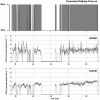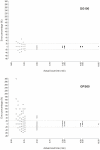The accuracy of a simple, low-cost GPS data logger/receiver to study outdoor human walking in view of health and clinical studies
- PMID: 21931593
- PMCID: PMC3172201
- DOI: 10.1371/journal.pone.0023027
The accuracy of a simple, low-cost GPS data logger/receiver to study outdoor human walking in view of health and clinical studies
Abstract
Introduction: Accurate and objective measurements of physical activity and lower-extremity function are important in health and disease monitoring, particularly given the current epidemic of chronic diseases and their related functional impairment.
Purpose: The aim of the present study was to determine the accuracy of a handy (lightweight, small, only one stop/start button) and low-cost (∼$75 with its external antenna) Global Positioning System (GPS) data logger/receiver (the DG100) as a tool to study outdoor human walking in perspective of health and clinical research studies. Methods. Healthy subjects performed two experiments that consisted of different prescribed outdoor walking protocols. Experiment 1. We studied the accuracy of the DG100 for detecting bouts of walking and resting. Experiment 2. We studied the accuracy of the DG100 for estimating distances and speeds of walking.
Results: Experiment 1. The performance in the detection of bouts, expressed as the percentage of walking and resting bouts that were correctly detected, was 92.4% [95% Confidence Interval: 90.6-94.3]. Experiment 2. The coefficients of variation [95% Confidence Interval] for the accuracy of estimating the distances and speeds of walking were low: 3.1% [2.9-3.3] and 2.8% [2.6-3.1], respectively.
Conclusion: The DG100 produces acceptable accuracy both in detecting bouts of walking and resting and in estimating distances and speeds of walking during the detected walking bouts. However, before we can confirm that the DG100 can be used to study walking with respect to health and clinical studies, the inter- and intra-DG100 variability should be studied.
Trial registration: ClinicalTrials.gov NCT00485147.
Conflict of interest statement
Figures


References
-
- Bouchard C, Blair SN, Haskell WL. Physical activity and health; In: Bouchard C, Blair SN, Haskell WL, editors. Champaign (Ill.): Human Kinetics; 2007. 409
-
- Hakim AA, Petrovitch H, Burchfiel CM, Ross GW, Rodriguez BL, et al. Effects of walking on mortality among nonsmoking retired men. N Engl J Med. 1998;338:94–99. - PubMed
-
- Lee IM, Rexrode KM, Cook NR, Manson JE, Buring JE. Physical activity and coronary heart disease in women: is “no pain, no gain” passe? Jama. 2001;285:1447–1454. - PubMed
-
- Manson JE, Greenland P, LaCroix AZ, Stefanick ML, Mouton CP, et al. Walking compared with vigorous exercise for the prevention of cardiovascular events in women. N Engl J Med. 2002;347:716–725. - PubMed
-
- Manson JE, Hu FB, Rich-Edwards JW, Colditz GA, Stampfer MJ, et al. A prospective study of walking as compared with vigorous exercise in the prevention of coronary heart disease in women. N Engl J Med. 1999;341:650–658. - PubMed
Publication types
MeSH terms
Associated data
LinkOut - more resources
Full Text Sources
Medical

